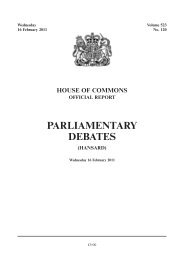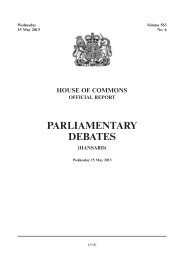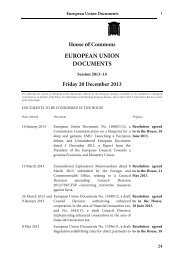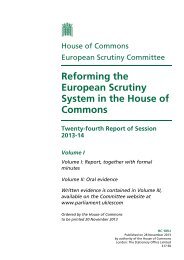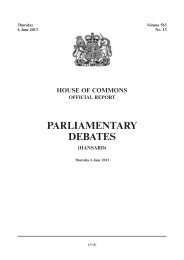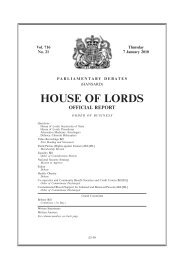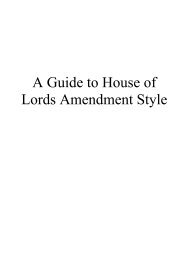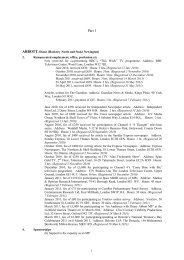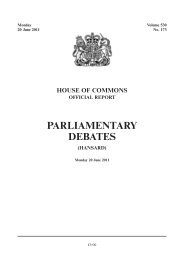here - United Kingdom Parliament
here - United Kingdom Parliament
here - United Kingdom Parliament
Create successful ePaper yourself
Turn your PDF publications into a flip-book with our unique Google optimized e-Paper software.
917 National Policy Statements 1 DECEMBER 2010 National Policy Statements 918<br />
EN-1 states that under some of our pathways some<br />
revisions have taken the scenario beyond 2025 towards<br />
the 2050 targets. It states:<br />
“Under some of our 2050 pathways, energy would need to be<br />
virtually emission-free”.<br />
Tessa Munt: Does the hon. Gentleman agree that the<br />
Infrastructure Planning Commission successor body<br />
appears to be carbon-blind in its decision making under<br />
the arrangements? The IPC successor body should give<br />
significant weight to any project’s carbon emissions and<br />
ensure that cumulative emissions from the various projects<br />
do not jeopardise the UK’s carbon targets and their<br />
budgets. The national policy statement should provide<br />
an additional safeguard to that process.<br />
Dr Whitehead: The hon. Lady is absolutely right. In<br />
response to the Energy and Climate Change Committee<br />
report examining the previous national policy statements<br />
the Government have accepted they need to undertake<br />
some sort of spatial planning arrangement which will<br />
look at the cumulative impacts between various<br />
arrangements as they progress. She is also absolutely<br />
right that in this NPS that question of decarbonisation<br />
of supply needs to be part of the process, not anterior<br />
to it. The current level of emissions of our energy<br />
supply means that if we are to get to that position, gas<br />
at about 450 grams per kWh unabated probably will<br />
have no part to play in the energy economy by 2030—when<br />
abated, it comes in at about 100 grams per kWh.<br />
What are we planning? What are we looking for in<br />
these overarching documents? According to EN-1, we<br />
are planning to require a capacity of about 113 GW of<br />
installed power sources by 2025, which is a substantial<br />
increase on 2010 levels because of the penetration of<br />
wind, in particular. According to the scenario of that<br />
capacity projection, wind needs greater capacity to balance<br />
its variability. So the 113 GW, which is an increase on<br />
the about 80 GW of installed capacity that we have at<br />
the moment, will need to be installed by that point.<br />
However, 22 GW are expected to go offline, including<br />
most nuclear plants and a number of power plants,<br />
under the large plant directive and the industrial emissions<br />
directive. So 59 GW of new power will need to be built<br />
between now and 2025, one way or another.<br />
If we reach the renewables targets for wind, and we<br />
probably will, given the amount of wind power already<br />
in planning, we will have about 33 GW of wind power<br />
on the grid. That means that we will need 26 GW of<br />
new build non-renewables or non-wind. Of whatever<br />
type, they will, for the reasons I have outlined, need to<br />
be low-carbon or lowish-carbon. Some 8 GW are under<br />
construction and almost all that construction relates to<br />
gas. That leaves a balance of 18 GW. Some 9 GW is not<br />
under construction but has planning permission. The<br />
Government dismiss that as uncertain, but 5 GW of<br />
that relates to gas; plans for a further 7 GW are under<br />
consideration, most of which also relates to gas. So it<br />
appears that most of the current gap is set to be<br />
made up by gas. As the Select Committee has been<br />
told by the Committee on Climate Change, more gas is<br />
in the pipeline in terms of planning, permissions or<br />
build than we need for that future decarbonisation<br />
strategy to work.<br />
The NPS says that<br />
“it would be for industry to determine the exact mix of the<br />
remaining 26 GW of required new electricity capacity, acting<br />
within the strategic framework set by the Government”.<br />
If industry decides as it appears to be deciding, it will<br />
choose gas. If it is to be gas and that gas is unabated or<br />
only partially abated, the decarbonisation of our electricity<br />
supply will not happen.<br />
David Mowat (Warrington South) (Con) rose—<br />
Dr Whitehead: I am sorry but I have to make progress<br />
because I will not get injury time for the second intervention<br />
I take.<br />
Mr Deputy Speaker (Mr Lindsay Hoyle): You will,<br />
Alan.<br />
Dr Whitehead: Okay, then I will take the intervention.<br />
David Mowat: Thank you for your help on that<br />
matter, Mr Deputy Speaker. I agree with the hon.<br />
Gentleman’s point about decarbonisation, but it prompts<br />
the question: how much cost penalty would he advocate<br />
as reasonable in order for us to go down the route of a<br />
totally carbon-free mix in the way he is suggesting?<br />
Each household in the country already pays about<br />
£50 for the renewables obligation. The implication of<br />
his remarks is that the sum should be very much higher.<br />
I wonder whether he has thought about that.<br />
Dr Whitehead: Indeed I have. I think we will find out<br />
considerably more about that in the material that will<br />
come out on energy market reform, particularly the<br />
details on what a carbon floor price will look like and<br />
what capacity payments will look like to keep the energy<br />
balance more decarbonised in future. Yes, that will add<br />
costs to the system and t<strong>here</strong> need to be circumstances<br />
in which those can be abated for the public, but that is a<br />
particular issue for the energy market reform material<br />
to address.<br />
When the Minister was asked in the recent Energy<br />
and Climate Change Committee sitting about the gap<br />
that I have mentioned he said that it is possible that<br />
16 GW of the 18 GW gap could be new nuclear. That<br />
represents 10 new nuclear power stations by 2025, and<br />
although that would solve the gap problem it has the<br />
unfortunate downside of being in<strong>here</strong>ntly implausible.<br />
The Minister may want to rectify what he said in the<br />
light of that implausibility at a future date.<br />
The Committee on Climate Change’s estimate for the<br />
nuclear roll-out, produced in 2009, said that t<strong>here</strong> would<br />
be a maximum of three nuclear power stations online<br />
by 2020, even based on optimistic build and planning<br />
time scenarios. Indeed, as we have seen, the timing of<br />
the justification process has already slipped.<br />
That leaves a gap that is not filled by nuclear. It is<br />
clear at the moment that t<strong>here</strong> is an apparent contradiction<br />
in our national planning statements. We want to decarbonise<br />
our supply, but for 2025 we are pushing towards having<br />
a majority of gas as opposed to a small amount of<br />
peripheral gas at peaking periods, which is what our<br />
future energy supply should be based on.<br />
That is compounded by NPS EN-5, which attempts<br />
to collate permissions for plant and line. It will t<strong>here</strong>fore<br />
replicate the question of providing grid capacity for<br />
plants as they stand and not provide new grid capacity



